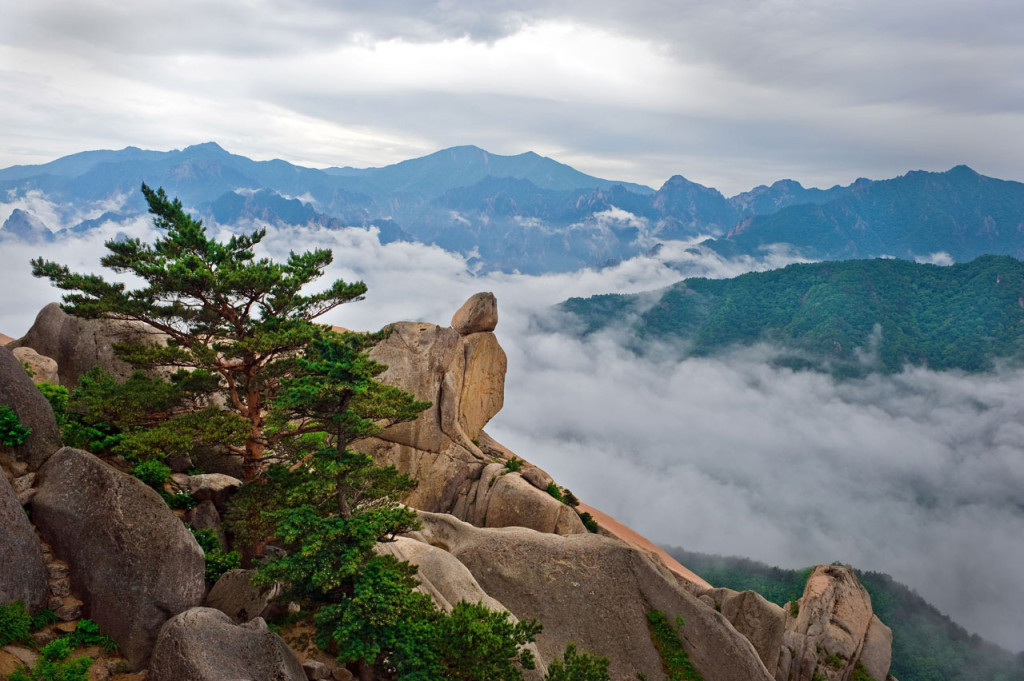
South Korea’s mountains make for some inspiring scenery but also leave little land to cultivate or settle on. Photo © Maxim Tupikov/123rf.
South Korea consists of the southern half of the Korean Peninsula, which juts out from China’s northeast toward Japan’s southern islands. Flanked by the Yellow Sea to the west and the Sea of Japan (or the East Sea, as the Koreans would prefer everyone called it) to the east, and bordered to the north by the tightly sealed Demilitarized Zone (DMZ) that separates it from North Korea, South Korea is effectively an island itself. With a total area of around 100,000 square kilometers (38,600 square miles), the country is about the same size as Hungary or Portugal. Some 70 percent of the peninsula is covered by mountains, which make for some inspiring scenery but also leave little land to cultivate or settle on; hence the population is largely clustered in a few dense cities. Much of the South Korean coast is rocky and windswept, though the southeast in particular boasts a few pleasant sand beaches.The largest of these agglomerations is the capital, Seoul, which lies in the northwest just a few dozen kilometers from the inter-Korean border. Seoul is hemmed in by mountains and bisected by the broad Han River, which flows through the northern stretch of the country before emptying into the Yellow Sea near the west coast city of Incheon, a major port and industrial center.Other major waterways include the Nakdong, which stretches from the country’s center to the southeastern port of Busan, South Korea’s second-largest city. With its seaside perch and many hilltop homes, Busan enjoys one of the country’s more unique locations; it is the nexus of the southern industrial heartland, which also encompasses the nearby towns of Ulsan and Daegu. This region developed a reputation for grit and pollution in the rapid urbanization of the 1970s and 1980s, but tighter environmental regulations have improved things greatly. The northeastern province of Gangwon, by contrast, was and still is known for its green spaces and the alpine vistas of the Taebaek mountain range.
The lush coastal plains of the west serve as South Korea’s agricultural center, a place characterized by wide expanses of rice fields, orchards, and tea plantations, as well as sizable cities such as Gwangju and Jeonju.
Much of the South Korean coast is rocky and windswept, though the southeast in particular boasts a few pleasant sand beaches. Scattered in the surrounding oceans are dozens of picturesque islands, the most renowned of which is Jeju, an oval-shaped outcrop 100 kilometers (60 miles) south of the peninsula that draws holidaymakers with its balmy temperatures and distinctive geological features, including a network of lava caves and cone-shaped Mount Halla, a dormant volcano that is the country’s highest peak.
The country’s four distinct seasons are a great source of pride to South Koreans, and while it is true that they can be differentiated easily, some last a lot longer than others. South Korea has a temperate climate characterized by sweltering humid summers and chilly winters—but the all-too-brief spring and autumn are just about perfect. Despite its limited size, there’s a fair amount of climactic variation from one end of the country to the other, with the southeastern port of Busan five degrees warmer in winter on average than Seoul in the north.
Spring comes to the peninsula in mid-March to early April in a shower of blossoms and foliage, with temperatures rising rapidly until June, the onset of summer, when they average over 20°C (68°F).
While the country isn’t as vulnerable to flooding or typhoons as some of its southern neighbors, late June and early July are often ruled by the jangma, the local name for a seasonal monsoon that dumps most of the national annual rainfall in a few short weeks and pushes humidity up to 80 or 90 percent.
August and most of September are also hot and fairly sticky, with temperatures peaking at around 30°C (86°F). By October the peninsula has dried out somewhat, and autumn is well under way; it is a glorious time of year when the air is crisp, the skies clear, and the mountains are swathed in vivid shades of gold and red. This usually lasts just a few weeks until mid-November, when temperatures drop and winter begins to take over.
January and February are the coldest months, with strong winds, temperatures regularly dipping below 0°C (32°F), and snow not uncommon in northern areas or at higher elevations.
Excerpted from the Second Edition of Moon Living Abroad South Korea.